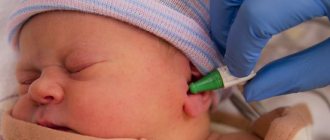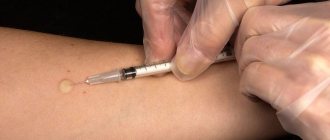Currently, there is active debate about the benefits and harms of various vaccinations. Some parents are not afraid and agree to have their children vaccinated from the very first days of their lives. Others categorically refuse such manipulations for many years. Who is right? Most doctors say that vaccinations are mandatory. However, it is necessary to take into account the condition of the baby and his well-being. In this article we will answer the question of whether it is possible to do Mantu for a runny nose. You will learn the main opinions of specialists and experienced parents on this matter. It is also worth saying how the Mantoux reaction for a runny nose is assessed and whether any inaccuracies may arise.
Is it possible to do?
For runny nose and cough
Many children, unfortunately, are susceptible to frequent colds, but this does not eliminate the need for tuberculin tests.
If a child is sick, parents fear that the administration of tuberculin will further worsen their child’s condition. First, you should make sure that your runny nose and cough are actually caused by a cold and not an allergic reaction. The symptoms of the two can be very similar. If an allergic reaction in the form of rhinitis is regular, this is not a reason to refuse the Mantoux test.
If the problem is still a cold, then rhinitis and cough, dry or wet, will not become stronger under the influence of the drug for mantoux. In some cases, general weakness may appear that is not associated with a cold. But a weakened body can give a false positive reaction to a tuberculosis test, so it is better to wait for complete recovery, and only a couple of weeks after that return to the question of performing Mantoux.
For ARVI
During viral infections, the body's defenses are undermined, and the immune system is aimed at fighting the causative agent of the disease. Therefore, if at this moment the child was given a manta, the reaction can also be positive or questionable.
In many cases, viral infections are a strong stress for the body and are sometimes expressed by unexpected symptoms. Therefore, it is better to wait with any intervention during this period until the immune defense is completely restored.
At a temperature
A rise in temperature is evidence of a malfunction in the body. Perhaps this is a signal that the child is beginning to develop an infection or inflammatory process. It is worth observing his condition for several days before deciding whether mantu can be done, and then consult with a pediatrician.
If this is a short-term temperature jump associated, for example, with the vigorous activity of a child who has just been energetically running and jumping, this is not a reason to cancel the test. In any case, before administering tuberculin, it is necessary to monitor the condition of the throat and general health.
For other diseases
You can wait out the infection, but what to do if there is a chronic pathology in the body? Is it possible to administer manta to a patient who has been suffering from dysfunction of internal organs and systems for a long time? There are clear contraindications to the test when:
- epilepsy;
- rheumatism;
- bronchial asthma;
- severe allergies;
- rashes and other skin disorders at the injection site.
Tuberculin has no effect on the course of these diseases, but the test results cannot be considered reliable. For any other serious chronic disease in the acute stage, it is recommended to refrain from the mantoux test until the period of remission
Another important contraindication is vaccination. If a month has not passed after any of the vaccinations, you should wait a while with mantu
What causes complications after vaccination?
Today, only purified and safe vaccines are used, manufactured using the latest advanced equipment, which greatly reduces the risk of complications. However, there are skeptics who speak out against vaccination, citing its negative consequences, such as:
- allergy;
- local inflammation;
- individual intolerance to the components of the drug;
- complications due to the physiological characteristics of the body.
Causes of a runny nose
A runny nose in itself is not a reason to cancel vaccination. But it is not for nothing that children are required to undergo a medical examination before vaccination.
This is necessary in order to correctly assess the child’s health status and eliminate the possibility of complications from vaccination.
And if at this time the child has a runny nose, then this is a reason for the doctor to find out the cause and, depending on the results, decide whether to allow him to be vaccinated or not.
Is it possible to do Manta or Diaskintest if a child has snot?
Is it possible to make Manta if a child has snot? If they are accompanied by elevated temperature, which indicates a developing infectious process, then it is better to postpone Mantoux.
- local inflammation at the injection site;
- promote an increase in body temperature;
- development of an allergic reaction and other complications.
Such reactions will significantly distort the diagnostic picture. You should wait until the baby recovers so that his body’s reaction to the tuberculosis pathogen is more natural.
Vaccination against hepatitis B for a runny nose
Every sane adult understands that routine hepatitis B vaccinations are extremely important and necessary to keep their children healthy. Is it possible to get vaccinated against hepatitis B if you have a runny nose?
DTP vaccination and runny nose
So is it possible to get an ADKS vaccine if a child has a runny nose? If there is snot, but the baby does not have a temperature, then you need to focus on his general well-being.
When the eyes are watery against the background of a runny nose, there is even a slight cough, or there is some kind of rash, then the vaccination should be postponed.
If, apart from a runny nose, there are no other symptoms, the child constantly has snot, he has a good appetite, and feels excellent, then the vaccination can be done.
Vaccination against measles, rubella, mumps for a runny nose
Is it possible to get the measles, rubella, mumps vaccine if you have a runny nose? The recommendations are the same as for DTP - focus on the overall well-being of the baby and if there is the slightest deviation, it is better to postpone vaccination. But if the snot has been running for a long time, there is no fever, and you feel good, then you can get vaccinated with your doctor’s permission.
- Is a child contagious after polio vaccination?
- Is a child contagious after polio vaccination?
- Is a child contagious after polio vaccination?
https://privivku.ru/detyam/mozhno-li-delat-rebyonku-privivku-pri-nasmorke.html
No comments yet!
How long after illness can Mantoux be done?
If at the time of examination the doctor identifies contraindications to the procedure, then the tuberculin test is not completely excluded, but simply postponed.
According to official documents, the medical withdrawal period is one to two months from the moment of recovery, which depends on the specifics and severity of the disease.
For example, after suffering from acute respiratory viral infection, you can come for a test within a month, while for pneumonia it is advisable to give two months for recovery. If the doctor is in doubt about when to test, then it is best to take a detailed blood test, which can help rule out allergic changes and sluggish infection.
Many parents are also interested in the question: is it possible to go for a walk after Mantoux. The procedure performed does not restrict the child from walking in any way, the only thing is that it is advisable to avoid contact with infectious patients
Is it possible to do Diaskintest for a sick child?
Before the test, both adults and children undergo a medical examination. A health check is necessary, since it is impossible to do a diaskintest if you are ill, especially with damage to the respiratory tract.
Restrictions are necessary due to the nature of the test. During the procedure, instead of a pathogen, genetically modified proteins are introduced into the blood, causing a reaction only if the tuberculosis bacillus is present in it. In an organism affected by pathogens, the immune system is activated to fight pathogens, which distorts the test results.
Vaccination against the background of the disease causes the following side effects:
- allergy;
- increased symptoms of the disease;
- decreased immunity;
- heat;
- compaction at the injection site.
There is no point in doing a test during illness, but the doctor may suggest performing the procedure if there is a slight runny nose unaccompanied by other symptoms. In this case, the choice of whether to give the baby a test or to postpone the procedure remains with the parents. However, no specialist will insist on conducting a test in the midst of an epidemic.
Is it possible to do Diaskintest if you have a cold?
Testing for tuberculosis when you have a cold is not recommended. The presence of infection in the body is likely to distort its effect. Colds often cause a false-positive result, and further tests do not detect tuberculosis.
A cold can easily develop into or be the first symptom of any serious respiratory disease. Complications that can harm all body functions are also possible.
The following side effects occur as a consequence of getting vaccinated during a cold:
- Increased symptoms.
- Headache.
- Nausea.
- Dizziness.
A cold, no matter how mild it may seem, is an absolute contraindication for Diaskintest. Vaccination should be postponed until complete recovery.
Is it possible to do Diaskintest for coughing?
The cough itself is only a symptom. It occurs for various reasons, which include:
- cold;
- acute respiratory diseases;
- stress;
- osteochondrosis;
- cardiovascular diseases;
- increased stomach acidity;
- smoking.
All this is related to health problems, but only in case of cough caused by a cold or infectious diseases, the discintest is contraindicated.
In some cases, "smoker's cough" may be a sign of chronic bronchitis. An examination is necessary to find out for sure.
Before getting vaccinated, you need to determine the cause of your cough, then the doctor will be able to tell you for sure whether you can undergo the test. The cough that appears after Diaskintest is most likely an allergic reaction.
Is it possible to do the Diaskin test at a temperature
If elevated temperature is a symptom of an infectious disease, diaskintest cannot be performed.
In the case when the temperature is not accompanied by other signs of a cold, the reasons are as follows:
- stress;
- increase in external temperature;
- physical activity;
- any injury (cut, foreign body, frostbite, burn);
- spoiled food;
- allergy;
- drinking alcohol or hot drinks.
There are no visible contraindications for vaccination. However, it is advisable to postpone the test at a temperature, since it itself sometimes provokes an increase in temperature against the background of an allergic reaction.
In women, fever sometimes occurs during menstruation. In this case, it is recommended to postpone the Diaskintest until completion in order to avoid a false positive reaction.
Is it possible to do Diaskintest for allergy sufferers?
Diaskintest is carried out for chronic allergies. Bronchial asthma, dermatitis, allergic rhinitis and food intolerance are not an absolute contraindication.
However, the test can cause an allergic reaction, like any medication:
- Redness at the injection site, spreading redness to the entire forearm.
- Purulent formations.
- Skin rash, itching.
- Labored breathing.
- Runny nose, cough.
If a severe allergic reaction occurs, you should immediately consult a doctor. The sample results will not be evaluated. If you know you have an allergy, tell us before the test, even if the allergy test is negative.
To avoid side effects, allergy sufferers should prepare in advance for vaccination: a week before the test and for several days after it, have as little contact with pathogens as possible, and take antihistamines.
The essence of the procedure
In fact, the annual vaccination against tuberculosis is not such, although the principle of the administered drug is based on a similar system. Direct vaccination against a specific disease is usually carried out a year before the first test and is called BCG, but the tuberculin test is an immunological test.
Subcutaneous administration of the drug makes it possible to detect the presence of a given type of infection or immunity to it.
A negative reaction during the procedure can show both a lack of resistance to the disease and severe allergic reactions. A detailed consideration of the issue is usually carried out in specialized institutions - tuberculosis dispensaries.
Conducting a specific test of the child’s immune system is quite important - timely detection of signs of infection makes it possible to quickly and efficiently carry out treatment. No actual preparation is required before infiltration of the drug. The only condition is the restriction in taking antiallergic drugs before the test and during the established test period - three days. The main reason for the ban is a decrease in the accuracy of the result, and the body’s reaction will differ from the natural one.
It may also be interesting: It is important for mothers to know how to treat a runny nose in a child under one year old
Mantoux test specification
The Mantoux test is performed once a year to examine the child population for sensitivity to tuberculosis bacteria. Medicine considers this diagnostic method to be the most reliable. Its necessity is:
- initial determination of the presence of pathogens;
- substantiation of an infection that already exists in the body;
- identify people who have the status of carriers of infection without signs of its manifestation;
- conducting the selection of children who need to receive repeated preventive BCG vaccination;
- note the number of patients with a positive result (papule with a diameter of six or more millimeters).
It is carried out as an intradermal injection with the introduction of tuberculin. The general condition does not change after this manipulation. Body temperature remains within normal limits. It is the injection site with a possible reaction that is subsequently assessed on the third day after administration.
The results are divided into several valid options:
- negative, the size of the seal does not exceed one millimeter;
- doubtful if the boundaries of the papule reach four millimeters;
- a positive result when the result is five or more millimeters;
- a pronounced infiltrate with a diameter of more than sixteen millimeters, after which it is necessary to carry out an auxiliary additional examination of the child.
If the result is positive, this does not mean that the baby is sick or that there is an infection in the body that provokes the development of tuberculosis. For an objective analysis of the sample, it is necessary to remove all possible factors causing a positive reaction.
The following points influence the correctness of the result:
- weakened immunity;
- low-quality equipment for manipulation;
- an infectious disease suffered the day before;
- the presence of bacterial pathologies;
- manifestation of allergies;
- violation of the rules for transporting and storing a product that can be used to perform a tuberculin test.
There is an opinion that it is impossible for Mantoux samples to come into contact with water. It is true for the Pirquet test, which was carried out earlier instead of Mantoux. It is after the procedure of damaging the skin using a scarifier (a feature of the Pirquet test) that contact with water must be avoided.
The Mantoux reaction is done by intradermal administration of the drug, which does not in any way affect the change in the result when water gets into the injection site. But it is worth protecting the infiltrate from rubbing with a washcloth, applying cream or attaching an adhesive plaster.
These actions can lead to a false result. There is no need to try to disinfect the injection site with brilliant green or hydrogen peroxide, or try to bandage it. Do not allow your child to scratch or rub it.
Indications for the test
This diagnostic method, such as the Mantoux test, is used after the child reaches one year. From this age it is carried out once a year until the age of 15-16 years.
This regularity is justified by the fact that children's bodies are most susceptible to tuberculosis infection.
It is given to babies who have been vaccinated with BCG. If vaccination against tuberculosis was postponed to a later period or was not carried out, then before vaccinating the baby, he is first given a Mantoux test to make sure that he is not infected. However, the result is not an accurate indicator. Mantoux allows you to suspect a problem in order to send the baby for additional examinations and tests in order to confirm or refute the presence of tuberculosis.
This procedure is not mandatory, and parents may refuse to do it. However, in return, they must provide their child with another alternative diagnostic method, the results of which must be provided in writing to the educational institution that the child attends. These include:
- radiography;
- general blood analysis;
- enzyme immunoassay blood test.
Can this be done if you have a cough?
This is another symptom from the list of contraindications. However, it cannot be stated unequivocally that a child or adult should not be vaccinated if they have a cough. This is due to the fact that this symptom occurs for various reasons. For example, if the temperature is elevated or a sore throat appears, these are symptoms of a cold. When the pathological condition has just appeared, the body temperature rises at the same time; the child should not be vaccinated if he has a cough. In this case, the disease will progress, because the immune system is greatly weakened.
It is permissible to get a flu shot for a cough and runny nose if such symptoms are residual. This means that the body has overcome the cold, but a number of pathological processes are still developing, albeit much more slowly. It is better not to get a flu shot if your child is sick. Residual symptoms are not considered a reason to cancel vaccination in adult patients.
If a child coughs, it is often the result of a negative reaction caused by an allergen. Under such conditions, vaccination is not given to adult patients.
So, first they conduct an examination. Taking into account its results, a decision is made on further actions.
Factors distorting the results
To obtain a reliable result, when performing the Mantoux test, it is necessary to exclude distorting factors.
For example, the detection of a false-positive reaction of the body can be recorded in case of individual intolerance to the components of tuberculin, during infectious diseases, or if the child has relatives suffering from tuberculosis. Also, incorrect results are often obtained in the absence of routine BCG vaccination.
Mantoux and colds
https://youtube.com/watch?v=dx8aTINt-3A
Is it possible to make Mantu for a cold? Will this lead to false positive results and harm the baby's health? These questions worry many parents. And, according to doctors, it is not worth carrying out a diagnostic test if there are signs of a cold.
And this is explained not only by obtaining incorrect results, but also by an increased risk of the child developing complications due to acute respiratory infections. After the test, the baby’s body’s defenses weaken and he can no longer cope with the virus.
But there is still debate among scientists regarding the duration of the delay in conducting the test. Some argue that Mantoux can be performed already on the 10-14th day after the development of a cold, and even the presence of a slight runny nose does not matter.
But others are in favor of the idea that it is better to postpone the test until complete recovery, since before testing the child’s body, it needs to be given time to recover.
A completely healthy child’s body can also give an inadequate reaction to the introduction of tuberculin. It can manifest itself with various symptoms, for example:
- an increase in temperature to subfebrile;
- loss of appetite;
- drowsiness;
- weakness;
- dizziness.
Misconceptions and Myths
There is an opinion among parents that conducting tuberculin diagnostics significantly increases the risk of developing tuberculosis. However, according to experts, during the Mantoux test, a small amount of tuberculin containing killed bacteria is injected under the skin, which is quickly suppressed by the antibodies of the immune system, so you cannot get sick from the injection itself.
But after it, the body’s protective properties weaken, which increases the likelihood of infection. That is, a child may well catch tuberculosis, but not from vaccination, but after it due to weakened immunity.
There are certain conditions that may well arise after tuberculin diagnostics, requiring increased monitoring and visits to a doctor. These include:
- intestinal disorders (diarrhea, constipation);
- vomit;
- local rashes, inflammatory and purulent reactions.
The Mantoux test is not a contraindication to the introduction of a normal lifestyle. The baby can safely attend preschool institutions, walk and swim. However, for the first 24 hours after vaccination, it is recommended to adhere to a gentle regimen.
There are few conditions in which the Mantoux test is contraindicated. But if a child has a cold with pronounced clinical signs, a tuberculin test cannot be performed. This is explained by the presence of a large number of viruses and bacteria in the body. And if tuberculin is introduced at this moment, the immune system will direct all its forces to its elimination, and at this time infectious agents will actively multiply, leading to the development of serious complications.
Mantoux after illness
Its duration depends on several factors: the nature of the disease and the stage of its development. For example, for a cold, the maximum delay is 30 days from the moment of complete recovery.
If a child develops a complication in the form of pneumonia due to a cold, then in this case the medical withdrawal is extended to 60 days. In case of viral diseases (for example, chicken pox), the Mantoux test is postponed for 5-6 months, and in the presence of mononucleosis - for 1.5 years.
In any case, you should not agree to carry out the test already on the 2nd or 3rd day after the disappearance of cold symptoms. The immune system is still weakened, and the injection can provoke not only the re-development of the disease, but also the occurrence of serious complications.
How does the tuberculin test reaction manifest itself?
After subcutaneous injection of tuberculin, a specific inflammation is formed in the skin caused by immune cells. Particles of mycobacteria cause lymphocytes to flock to the site of tissue damage.
If the child’s body already had tuberculous mycobacteria, then the tuberculin test will attract a large number of protective agents and the inflammatory process will be more pronounced. In this option, you can declare a positive reaction to mantoux. By measuring the diameter of the papule and its density, the intensity of the immune system to the tuberculosis bacillus is determined.
The reaction to manta ray is considered one of the types of allergic manifestations, since tuberculin is more of an allergen than a full-fledged antigen. Therefore, if a child has symptoms of allergic phenomena or is prone to them, this will affect the test results.
Factors that distort mantoux results include:
- Chronic pathological changes
- Previous infectious diseases (recently)
- Child's age
- Developed immunity to mycobacteria (not tuberculosis)
- Injection problems
- Improper sample storage
- Using a low-quality tool
Therefore, even if a child’s body reacts positively to mantu, it cannot be guaranteed that he is infected with the tuberculosis bacillus. To make an accurate diagnosis, additional diagnostic procedures will be required. The doctor will refer the baby for fluorography, perform sputum culture, etc.
But a negative Mantoux result does not mean that the child is 100% free of Koch’s bacillus. There are cases when, in the presence of Mycobacterium tuberculosis, children do not show a positive reaction. This is due to the following reasons:
- The immune system cannot respond to the stimulus
- The child was infected in the last 2.5 months
- The baby is not yet 0.5 years old, his body does not respond adequately
Therefore, to answer the question: “Is it possible to eat mantu with a runny nose?”, you should remember that infectious inflammation in a baby will cause an incorrect result of a tuberculin test. That is, there is no point in giving an injection if it is known that it will not be possible to assess the exact state of the child’s body. In addition, mantu can reduce the immunity of a sick baby, causing complications of ENT disease.
What is Mantoux grafting? Why do they do it?
A tuberculin test, or a modified Mantoux test, is carried out to study the degree of immunity that should have been developed in response to the introduction of the causative agent of tuberculosis infection.
Initially, this reaction was called the Pirquet test and was performed using the scarification method (applying drops to the skin). However, several decades later, a doctor of French origin, C. Mantoux, suggested administering tuberculin only intradermally.
Important
Tuberculin is a complex substance made from pathogens or special culture filtrates of acid-fast bacteria (tuberculosis bacilli).
Being an inferior antigen, or hapten, it provokes the development of a delayed-type immunological reaction, which normally manifests itself 24-72 hours after administration.
The tuberculin test is difficult to overestimate, since it is a good protector against infection and shows an existing disease.
- To identify primary infection with acid-fast mycobacteria - the causative agents of tuberculosis.
- Confirm an infection already activated in the body that provokes the disease.
- Identify bacteria carriers who do not have any manifestations or complaints.
- Select a contingent of children in need of revaccination.
- Record the number of infected individuals with a post-vaccination infiltrate diameter of more than 6 millimeters within one year.
- Identify infected people with a hyperergic reaction to tuberculin administration.
Body reaction
1
The diameter of the infiltrate is up to 1 mm inclusive - this indicates a negative reaction. Thus, we can say that the child’s body does not have antibodies against tuberculosis bacilli.
This may be due to an incorrect BCG diagnosis (that is, the pathogen did not enter the body at all) or to immunodeficiency. 2
Isolated hyperemia or infiltrate from 2 to 4 mm is a questionable nature of the reaction, that is, there are anti-tuberculosis antibodies in the blood, but in low concentration. 3
The resulting infiltrate of 5 to 16 mm is a positive reaction, which indicates sufficient tension of the immune system. That is, when “meeting” a pathogen, the body is able to give an adequate response.
4
The size of the infiltrate exceeds 17 mm, the appearance of vesicles, necrosis or regional lymphadenitis is a hyperergic reaction, which most often indicates the active phase of tuberculosis. 5
The tuberculin test is set when a negative reaction changes to a positive one or when an infiltrate is diagnosed that is 6 mm larger than the previous one. It is a direct indication for consultation with a phthisiatrician.
Body reaction
In the usual situation of using a tuberculin vaccine during the mantoux test, the child’s body reacts locally, that is, only at the puncture site. The general health of children should remain normal. Based on the type of reaction to manta, the pediatrician determines the presence of infection in a particular child. The results are checked by measuring the linear dimensions of the inflamed area of skin. Decryption can be done according to the following parameters:
- negative reaction – the focus of inflammation is within 1 mm;
- questionable reaction – inflamed area measuring 2-4 mm;
- positive reaction - a spot formed at the puncture site, more than 5 mm;
- pronounced reaction - redness extends beyond 16 mm.
In cases with pronounced reactions to a tuberculin test, urgent health checks are required.
A positive result does not always indicate tuberculosis disease.
There are some reasons that can affect the accuracy of the check:
- the vaccine used in the test was spoiled;
- the sterility of the procedure and instrument was violated.
In addition to the above, there may be other nuances that could explain a false test result. However, even if additional tests did not find anything, children who had a positive reaction should undergo a full medical examination, because for some reason the immune system is weakened.
False positive reaction
Sometimes the test result shows a positive answer, but tuberculosis is not confirmed. The main reasons for a false-positive immunological test are:
- allergy to the components of the drug used for the test;
- other active infectious diseases;
- tuberculosis does not manifest itself at all.
You may also be interested in: How to help your baby relieve the painful symptoms of cough and runny nose
False negative reaction
There are confirmed cases of tuberculosis with a negative test. Such situations are usually explained by the following factors:
- weakened immunity is not able to react to tuberculin;
- tuberculosis infection occurred recently;
- at a young age, the immune system may react inadequately;
- taking antiallergic medications.
To obtain the most accurate result, there is a list of rules for maintaining the infiltration site. In order to avoid the influence of extraneous factors, you should:
- avoid the possibility of irritation;
- Do not apply any substances to the injection point;
- It is strictly forbidden to wet, rub or comb the manta ray.
When can you do Diaskintest?
Due to the small number of side effects and the low probability of their occurrence, Diaskintest is almost safe for health. It is recommended for elderly people, pregnant and lactating women. Even a one-year-old child can be tested for tuberculosis safely using this method. The sample does not contain the causative agent of the disease, but antigens present in strains of the tuberculosis bacillus.
Diaskintest checks the body for the presence of tuberculosis bacteria, which can cause this disease in the future. This differs from the Mantoux test, which can also react to traces of Koch’s bacillus in the blood, even if there are no microorganisms themselves in it.
The test is allowed if the patient does not have infectious diseases or other serious pathologies.
He is appointed:
- People at risk. It is determined by environmental, social, medical and epidemiological factors.
- People living in places where tuberculosis is widely detected.
- For children under 17 years of age, as an annual scheduled check.
Diaskintest is allowed to be carried out a month after another vaccination. In case of a negative result, a repeat test is prescribed no earlier than two months after the first test.
Many people wonder whether it is necessary to follow a certain diet after vaccination, giving up sweet, fatty foods, and alcohol. Doctors recommend that people with allergies avoid eating foods that cause an allergic reaction. However, there are no restrictions for healthy people. Drinking alcohol also does not affect the results of the Diaskintest, but increases the risk of side effects such as pressure surges, headaches, hardening at the injection site, or even fever.
Is it possible to do Mantu for a runny nose?
The most common symptom is a runny nose. It can have different etymologies, and this, in turn, determines whether a sample can be made or not.
- Allergy based. It is strictly forbidden to do Mantoux only during exacerbations. During the period of remission it is possible.
- Against the background of a viral infection. During illness, tuberculin diagnostics are prohibited. It is recommended to postpone it and do it a month after recovery. Although some doctors allow vaccination immediately after recovery or after two weeks. Ultimately, it depends only on the parents whether Mantoux can be given if: the child has just been ill, has residual signs of inflammation, has primary signs of the disease, or is currently ill.
- The combination of a runny nose with pain and redness in the larynx, and elevated body temperature is a clear sign of an acute respiratory disease or flu. Sample is prohibited.
You can get tested to determine the cause of your runny nose. In addition, doctors advise focusing on the color of the discharge. If it is clear mucus without additional symptoms, then tuberculosis diagnosis is acceptable. If a yellow or green tint appears, it is prohibited.
In general, experts do not consider a runny nose and cough a reason not to conduct subcutaneous diagnostics. In this case, it is up to the parents to decide. By law, they have every right to refuse or reschedule the procedure. Also, in any case, their consent is required, and the duty of health workers is to notify about the planned vaccination.
What to do if you have a runny nose after Mantoux?
The appearance of a runny nose after a tuberculin test is considered the most common problem. As a rule, snot goes away on its own, but it is worth monitoring a sick baby even more carefully so as not to miss the development of serious complications. The development of a runny nose and other cold symptoms indicates that the test was done when the baby was already sick. If you have a complex of acute respiratory infections symptoms after Mantoux, you should consult a doctor, because after the injection the disease can be quite complicated.
It is important to remember that tuberculin, the composition of the sample, contains only disinfected and safe fragments of mycobacterium tuberculosis. Since there are no live bacteria in the injection, it is simply impossible to get sick from the test. A runny nose that appears after the Mantoux test cannot be a sign of tuberculosis in a child. Most likely, the child became infected before the injection or while waiting for the test in a medical institution, communicating with sick children.
A runny nose after the Mantoux test may appear due to a weakened immune system, but it is impossible to get sick from the injection itself
Reasons for feeling unwell after Mantoux
Recently Mantoux was placed and the child fell ill due to the administration of tuberculin. All symptoms point to this.
The reasons may be of different nature, however, everything is normal if the following conditions are met:
- Fever occurs only 2-3 days later, and not immediately after vaccination.
- Itching and redness appear after the injection.
- The size of the halo around the injection site reaches 1.5 centimeters.
If the injection is done incorrectly, contamination and infection can occur. There is no guarantee that a child will not get tuberculosis from Mantoux.
Usually this is very similar to acute respiratory infections and acute respiratory viral infections, which is a cause for concern:
- Unbearable headaches.
- Unreasonable nausea and vomiting.
- Various types of skin rashes.
- Significant decrease in blood pressure.
- Hyperthermia (increased body temperature).
- Lethargy and fatigue even with minor exertion.
- Runny nose, nasal congestion.
Among the reasons for poor health, there are a number of factors that provoked a deterioration in the condition. These include periods of exacerbation of diseases.
What will happen to a child if Mantoux is given to him with a runny nose and cough?
A cold, which is accompanied by a runny nose and cough, is usually a direct contraindication to the Mantoux test. However, this opinion is controversial. Some doctors believe that snot is not a reason to postpone the test. Much depends on the nature of rhinitis:
- Allergic. As a manifestation of an allergy, a runny nose can cause complications after an injection, so the test cannot be performed.
- Catarrhal. During the period of exacerbation of the disease, Mantoux will only worsen the baby’s condition.
- Inflammatory. At the same time, the throat turns red and the temperature rises. It is strictly forbidden to further burden an already weakened immune system.
The nature of the discharge also plays an important role. If they are transparent, then the reagent can be administered with caution. Mantoux for a runny nose, when a child has green or yellow snot, can cause complications and distort the results. Moreover, tests should not be carried out if this symptom is accompanied by a cough. If you only have a cough, you should also undergo the manipulation, since this is a signal about the beginning of the development of a pathological process in the body.
Of course, we cannot exclude the development of side effects that may occur after the procedure:
- elevated temperature;
- skin rashes;
- nausea and vomiting;
- dizziness;
- inflamed lymph nodes located under the armpits and in the groin area.
Possible consequences
Adverse reactions after Mantoux may be related to the composition of the immunological drug, which includes:
- tuberculin - particles of killed tuberculosis bacteria;
- phosphate salts, which act as a buffer to inhibit microbes;
- phenol is a preservative of the drug, it is classified as a toxic chemical agent, although it is contained in minute quantities;
- Polysorbate Tween-80 is a stabilizer that can activate estrogen synthesis;
- saline solution of sodium chloride 0.9% is a harmless substance for the body.
Possible undesirable manifestations are most often caused by tuberculin and phenol.
At their core, complications are allergic in nature, these include:
- increase in temperature reaction to 38–39 °C, chills;
- catarrhal phenomena - cough, nasal congestion;
- from the gastrointestinal tract, loose stools or constipation, nausea with vomiting, and lack of appetite are possible;
- mild degree of astheno-neurotic syndrome - headache, general weakness, drowsiness;
- from the skin - hyperemia, infiltration, rashes all over the body in the form of urticaria;
- Pain and itching may occur at the injection site.
The causes of complications may be associated not only with the composition of the drug, but also with other factors.
Common reasons for the appearance of unwanted symptoms:
- errors in the production, transportation and storage of tuberculin;
- insufficient examination of the child before prescribing a reaction or poor preparation for the test;
- non-compliance by the nurse with the rules of the sanitary and anti-epidemic regime and the Mantoux administration technique.










